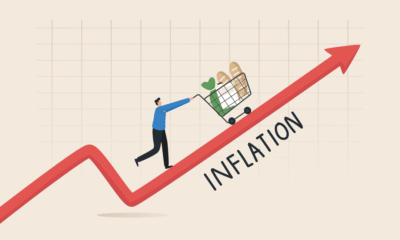Finance and Investing
Sensex and Nifty Rally Amid US-China Trade Optimism

Introduction to Sensex and Nifty
The Sensex and Nifty are two of the most prominent stock market indices in India, serving as essential barometers for the performance of the Indian economy. The Sensex, formally known as the Bombay Stock Exchange Sensitive Index, consists of 30 financially sound companies listed on the Bombay Stock Exchange (BSE). In contrast, the Nifty 50, maintained by the National Stock Exchange (NSE), comprises 50 of the largest and most liquid stocks from various sectors. Together, these indices provide invaluable insights into the market trends and overall health of the Indian economic landscape.
Both the Sensex and Nifty function as composite indices, utilizing a market capitalization-weighted methodology. This means that the companies with larger market capitalizations hold more significant sway on the index’s overall movement. Investors and analysts closely monitor these indices, as they reflect investor sentiment and economic stability. A rising Sensex or Nifty typically indicates positive investor sentiment, while a decline may signal economic concerns.
The significance of the Sensex and Nifty extends beyond mere performance indicators; they influence investment decisions, portfolio strategies, and even policy-making. For international investors, these indices serve as gateways to the Indian financial markets. The overall performance of the Sensex and Nifty can also impact foreign direct investments and affect the value of the Indian rupee against other currencies. Understanding these indices is crucial for anyone interested in investing within India’s evolving economic environment, especially during periods of market volatility or significant global events such as trade negotiations.
Overview of the US-China Trade Relations
The trade relations between the United States and China have significantly evolved over the years, marked by a series of pivotal events and negotiations that have shaped the global economic landscape. Historically, these two nations fostered a relationship that was primarily characterized by trade liberalization and mutual benefit. However, tensions began to surface in the late 20th century as both countries started to experience growing economic ambitions and competitive pressures.
The onset of the 21st century saw globalization playing a crucial role in deepening the ties between the US and China. However, the relationship took a sharp turn during the Trump administration when the US introduced a series of tariffs aimed at curbing what it perceived as unfair trade practices by China. This marked the beginning of a trade war that had significant implications not only for the economies of both nations but also for markets around the globe. The imposition of tariffs led to retaliatory measures from China, further escalating tensions and creating uncertainty within the business community.
In early 2020, a “Phase One” trade agreement was reached, aiming to address several contentious issues, including intellectual property rights, agriculture, and currency manipulation. While this agreement marked a temporary truce, lingering challenges remained, keeping negotiations ongoing. The complexities of US-China trade relations continue to impact investor sentiment worldwide, as uncertainties surrounding future agreements can lead to heightened volatility within global markets.
As both nations navigate their economic paths, the influence of their trade relationship extends beyond bilateral aspects, affecting markets, supply chains, and international trade dynamics. The current state of US-China relations is a pivotal area of focus for investors, as positive developments can spark optimism in the markets, whereas setbacks may lead to downturns, as evidenced by recent fluctuations in the Sensex and Nifty indexes.
Recent Developments in US-China Trade Talks
The ongoing dialogue between the United States and China regarding trade has shown signs of significant progress, greatly influencing global markets, including the Indian stock market. Recently, high-ranking officials from both countries have engaged in discussions that hint at potential agreements aimed at de-escalating trade tensions. Notably, there have been indications from the Biden administration that it is committed to a balanced approach, focusing on both containing competition and fostering cooperation with China. This shift in tone has been interpreted as a positive signal for investors, contributing to the rally in indices such as the Sensex and Nifty.
According to recent statements from trade representatives, both nations are showing willingness to compromise on key issues, such as tariffs and technology transfers. These developments coincide with a series of negotiations that have been held to address longstanding trade disputes. Analysts suggest that if these talks culminate in concrete agreements, they could alleviate the economic uncertainties that have plagued global markets for some time.
Additionally, the anticipation surrounding potential policy changes in areas like intellectual property rights and market access has generated optimism among traders and investors. As the trade talks progress, the market’s reaction showcases not only its responsiveness to diplomatic outcomes but also its inherent volatility influenced by external factors like these. The recent news has fueled market sentiments, with both the Sensex and Nifty experiencing upward trends as stakeholders remain hopeful for a resolution that could stabilize economic relations between the two largest economies in the world.
In the context of these developments, it is essential to continue monitoring updates from the trade talks, as they will undoubtedly shape the economic landscape in both countries and the broader global market. The unfolding situation exemplifies the interconnectedness of global trade and the potential ramifications for domestic markets.
Impact of US-China Relations on the Indian Stock Market
The dynamics of US-China trade relations play a significant role in shaping the performance of global markets, including India’s Sensex and Nifty. As investor sentiment is heavily influenced by news related to these two major economies, any indication of improved relations can lead to favorable market conditions. When the United States and China engage in meaningful dialogue and reach agreements, it alleviates fears of a prolonged trade war, which can create a ripple effect across global markets, triggering a bullish trend in Indian equities.
Investors often look for stability in the global economic environment, and a rapprochement between the US and China brings a sense of reassurance. This optimism translates into increased foreign investment flows into emerging markets, including India. The inflow of Foreign Institutional Investors (FIIs) can bolster the stock market significantly, leading to higher valuations of listed companies on the Nifty and Sensex. Conversely, any signs of escalation in trade tensions tend to deter foreign investments, leading to a downward trend in stock prices as investors adopt a more cautious approach.
Moreover, the overall economic climate of India can also be impacted by US-China relations, as trade policies between these two nations can influence India’s export performance and economic growth. For example, if tariffs are reduced or trade barriers are lowered, India may find itself positioned to export more goods, benefiting industries such as textiles, pharmaceuticals, and technology. Such growth can enhance investor confidence in the Indian stock market, leading to better performance of key indices like Sensex and Nifty.
In conclusion, the relationship between the US and China is not just a bilateral issue; it has far-reaching implications for the Indian stock market. The fluctuations in investor sentiment, the movement of foreign capital, and the economic prospects stemming from these relations are pivotal in dictating the performance of Sensex and Nifty.
Sector-wise Performance in the Rally
The recent rally in the Sensex and Nifty, largely driven by renewed optimism surrounding US-China trade relations, has manifested distinct performances across various sectors of the Indian economy. Notably, sectors such as technology, pharmaceuticals, and consumer goods have witnessed substantial gains, reflecting broader market sentiments and the influence of global trade dynamics.
The technology sector has emerged as a frontrunner during this bullish phase. Companies within this space have reported robust financial results, driven by increased demand for digital services and products. The sectoral index has notably outperformed other segments, buoyed by strong performances from major players who have secured lucrative contracts both domestically and internationally. Furthermore, the strengthening of trade ties is expected to further enhance the growth trajectory of this sector.
Similarly, the pharmaceutical industry has benefitted significantly from the rally. With global health demands surging and a potential easing of international trade tariffs, Indian pharmaceutical companies are poised to capture a larger share of the global market. Companies are experiencing growth not only in the domestic sphere but are also expanding their export capabilities, leading to optimistic projections for the sector’s future performance.
The consumer goods sector, another pivotal component of the market, has also shown impressive gains. Increased consumer confidence spurred by positive economic indicators has led to higher consumption rates. This trend is expected to continue as companies adapt and innovate their product offerings, capitalizing on favorable trade conditions. Moreover, the anticipation of improved economic activity supports the long-term outlook for this sector.
Overall, the varied sectoral performances amid the Sensex and Nifty rally underscore a significant correlation between trade optimism and market sentiments. As these sectors continue to evolve, tracking their developments will be crucial for investors aiming to capitalize on emerging opportunities stemming from the current market dynamics.
Investor Sentiment and Market Psychology
Investor sentiment plays a crucial role in shaping market dynamics, particularly during pivotal events such as the current US-China trade negotiations. When positive developments occur in trade talks, as has recently been the case, investors often exhibit heightened optimism. This optimism can drive a surge in market activity, contributing to significant indices such as the Sensex and Nifty experiencing rallies. The psychology of investors is frequently influenced by external factors, including global economic indicators and geopolitical events, which, in turn, shape their risk appetite and trading behavior.
The recent buoyancy in investor sentiment, stemming from optimism related to US-China trade negotiations, has encouraged market participants to increase their investments. As news of potential trade agreements circulates, traders are more likely to perceive the market as being on an upward trajectory. This positive perception bolsters confidence, leading to increased trading volumes and an influx of capital, thereby reinforcing the rally in major stock indices. Furthermore, optimistic sentiment can create a feedback loop, where rising stock prices attract more investors, further escalating the rally.
Moreover, the psychological effect of market trends cannot be overstated. Investors are often influenced by the behavior of their peers and the prevailing market mood. In an environment characterized by positive sentiment, even cautious investors are more inclined to enter the market, pushing demand higher for equities. Consequently, this shift not only solidifies market gains but also fosters a collective belief in sustained upward momentum. As we observe the ongoing rally in the Sensex and Nifty, it is evident that investor sentiment, fueled by optimism around the US-China trade relationship, is a significant driver of current market psychology.
Expert Opinions and Market Predictions
The recent rally of major Indian stock indices, including the Sensex and Nifty, has garnered considerable attention from market analysts and experts. Many attribute this surge to the optimism surrounding ongoing trade negotiations between the United States and China. The potential resolution of trade disputes could have far-reaching implications, not just for global markets but specifically for the Indian economy as well. Encouraged by positive signals from these talks, investors are increasingly optimistic about the prospects of sustained growth in equities.
According to several financial analysts, the rally is bolstered by stronger corporate earnings reports along with favorable government policies aimed at enhancing infrastructure and boosting investment. These factors are creating a conducive environment for market growth, making it essential for investors to stay informed about both domestic and geopolitical developments. The International Monetary Fund (IMF) has also hinted at a robust growth outlook for India, further enhancing market confidence.
Market experts suggest that while the current momentum is encouraging, it is crucial for investors to remain cautious. The unpredictable elements of the global trade environment, particularly relating to the US-China dynamics, could influence market stability. Some analysts project that if the trade talks culminate in a comprehensive agreement, it could propel Sensex to new heights, potentially crossing the 70,000 mark. Others, however, advise investors to be prepared for market corrections, particularly considering the volatility that often accompanies economic news and geopolitical developments.
In light of these insights, it is clear that the expert consensus emphasizes a balanced approach to investing during this period of rally. Keeping an eye on international trade relations, as well as broader economic indicators, will be crucial for anyone looking to navigate the increasingly complex landscape of Indian equities.
Potential Risks and Concerns
The recent rally in Sensex and Nifty, driven by optimism surrounding US-China trade relations, brings with it a myriad of potential risks that investors must cautiously consider. While the positive sentiment has bolstered market performance, underlying unresolved trade issues pose a significant threat to sustained growth. Despite the optimistic outlook, key areas such as tariffs, trade agreements, and bilateral negotiations remain tenuous and could easily shift, leading to market corrections.
Moreover, economic uncertainties continue to linger on the horizon. Global economic indicators remain mixed, with varying growth projections across major economies. Factors such as inflation rates, interest rate changes, and fiscal policies can significantly influence market stability. As these economic variables evolve, investors may find themselves in a precarious position, where the initial optimism fades in the face of downturns driven by inconsistent economic data.
Furthermore, global market volatility cannot be overlooked. The interconnectedness of financial markets means that a downturn in one region can rapidly affect others. For instance, geopolitical tensions or financial crises in different parts of the world could lead to increased volatility, adversely impacting investor sentiment in domestic markets such as Sensex and Nifty. Maintaining a diversified portfolio may help mitigate some of these risks, allowing investors to navigate challenges more effectively.
To manage the current uncertainty, it is essential for investors to stay informed and adaptable. Adopting a cautious approach, along with a focus on long-term investment strategies rather than short-term speculation, may provide a buffer against potential downturns. By understanding and recognizing these risks, investors can make more informed decisions, ultimately contributing to more stable returns amid the fluctuating market conditions.
Conclusion: Future of Sensex and Nifty Amid Global Changes
The ongoing fluctuations in the global market, particularly arising from US-China trade relations, have significant implications for the Indian stock market, notably for Sensex and Nifty. Throughout this blog post, we have explored how the recent rally in these indices correlates with the optimism surrounding trade discussions between these two economic giants. As developments unfold, it is vital to recognize the symbiotic relationship that exists between international market sentiments and the performance of local indices.
Historically, Indian markets, including Sensex and Nifty, have reacted sensitively to news regarding global trade. These indices, representing the broader health of the Indian economy, often mirror the investor sentiment that arises from geopolitical dynamics. The positive momentum indicated by the recent rallies could signal not only a recovery from past downturns but also the potential for sustained growth, contingent on the stability of trade discourse between the US and China. Continued dialogue may reinforce investor confidence, thereby allowing for further upward movement in these indices.
Furthermore, this interconnectedness is also a reminder of the broader macroeconomic factors at play, such as inflation rates, monetary policies, and technological advancements influencing global trade. As such, the future of Sensex and Nifty will likely be shaped by how these factors evolve in conjunction with trade discussions. For investors and analysts, monitoring these changes can provide valuable insights into potential market movements. In summary, while the rally offers hope, caution is advisable, as global developments remain unpredictable and could lead to market volatility. Consideration of both local and international influences will be essential for stakeholders seeking to navigate the complexities of the Indian stock market in this dynamic environment.

-

 Finance & Investment6 months ago
Finance & Investment6 months agoEmerging Markets to Watch in 2025: Opportunities and Risks
-

 Technology and Finance8 months ago
Technology and Finance8 months agoThe Future of Quantum Computing in Financial Modeling and Trading
-

 Finance7 months ago
Finance7 months agoUSA Market Trends & Global Finance Insights
-
Finance7 months ago
Navigating Retirement in the Gig Economy: Challenges and Solutions
-

 Finance8 months ago
Finance8 months agoNavigating Personal Finance in the Age of Inflation and High Interest Rates
-

 Economics6 months ago
Economics6 months agoGlobal Markets React to U.S. GDP Contraction: A Comprehensive Analysis
-

 Investing & Finance8 months ago
Investing & Finance8 months agoFractional Investing: The Path to Wealth Democratization
-

 Finance7 months ago
Finance7 months agoTop 10 High-Yield Savings Accounts in the US (2025 Edition)







